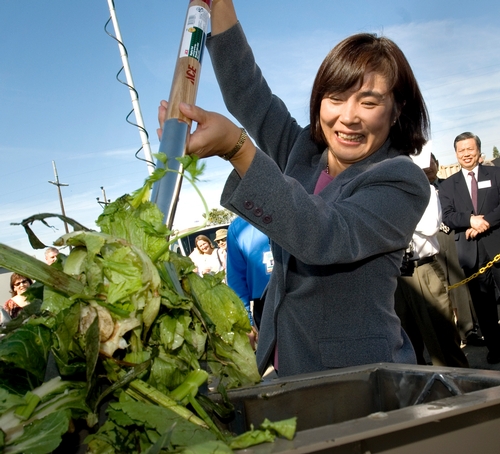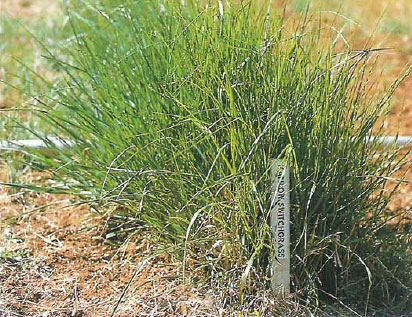Posts Tagged: energy
The new grid
Take a look at the nearest light switch: is it up or down? The answer means more than you think. When you flip a switch — or run a washing machine, or plug in a space heater — you’re creating demand. And on a vast, interconnected electrical grid like California’s, supply must always meet demand. Otherwise, it’s lights out.
For more than a century we’ve taken the balancing act between supply and demand for granted, and for the most part, it’s worked. To accommodate sudden spikes in demand, engineers overbuilt the grid with excess slack, including wires that were thicker than they needed to be and standby fossil-fuel power plants that could fire up at any instant.
But today our 19th-century grid is being inundated by 21st-century innovations — among them the remote, large-scale solar and wind plants that are leading the state toward its clean-energy future. California has added nearly 2,800 megawatts of renewable energy capacity this year, almost equal to what it gained in the previous 13 years combined, the California Public Utilities Commission reports. In response to the Global Warming Solutions Act, or AB 32, the state has required its three largest utilities to acquire at least 33 percent of their power from renewable sources by 2020, up from the current 21 percent. Some analysts — and utilities — are aiming for well over 40 percent.
These new energy sources fluctuate according to nature’s whims and can’t be switched on at a moment’s notice. The more we rely on solar and wind to replace steady sources like fossil fuels, the less slack remains in the system, and the smaller the margin gets between peak supply and peak demand.
“Renewables integration into the grid poses a fundamentally new problem,” says Sascha von Meier, co-director of electric grid research for the California Institute for Energy and Environment. In various ways, von Meier says, the solar and wind energy that most of us in California are clamoring for — or already installing on our rooftops — is slowly transforming the system through which we deliver and receive power. And we’re not entirely sure what to do about it.
Many of the state’s top energy thinkers — including researchers at UC Berkeley’s Energy and Resources Group (ERG) and College of Natural Resources, and their graduates now employed within the industry — are working to find an answer. In the end, it’s clear that no single approach will do; rather, a blend of public policies, technological innovations, energy-storage solutions, and increased flexibility on the demand side (that means you and me) will work together to help California reach its clean-energy goals and push well beyond them.
—Excerpted from an article in the fall 2012 issue of Breakthroughs Magazine. Read the complete article.
UC Davis voted America’s “coolest” school
After just experiencing my first Davis summer, I find it hard to describe anything in Davis as cool. But according to Sierra Magazine, UC Davis is just that. So much so, that the school was recently named the #1 Coolest School in the nation. Granted, they weren’t talking about the weather. Instead, they were referring to UC Davis’ environmental stewardship.
With all that UC Davis does to create and promote environmentally friendly programs and facilities, it’s no wonder the university just received this high honor. The campus is on track to reduce campus greenhouse gas emissions back to 1990 levels by 2020 and reduce campus electrical use by 60 percent by 2015.
UC Davis also provides sustainable forms of transportation to 85 percent of students and 46 percent of employees. As a fairly new Davis resident, I’m still constantly blown away by the number of bikes on campus, especially during the first week of school. Being from Long Beach, I always feel a pang of culture shock watching the Davis police handing out bike traffic violations instead of combating violent gang activity.
In 2011, UC Davis encouraged recycling, composting and reuse efforts that prevented 64 percent of campus waste from entering landfills. Sierra Magazine praised the university for its green purchasing, spending more than 20 percent of its $5.6 million food budget on local and organic products.
UC Davis also received international attention last fall, when it officially opened the doors to UC Davis West Village, the nation’s largest planned zero net energy community.
“At UC Davis, sustainability is one of our core values,” said UC Davis chancellor Linda P.B. Katehi. “I am very proud of the students, faculty and staff who have worked so hard to make this achievement possible and to invest in a more sustainable future for our campus.”
Other California schools that made the top 10 included Stanford University at number 3, and UC Irvine at number 9. California had the highest contingency of schools in the top 10 list.
Congratulations to UC Davis, for earning the title of Coolest School in the middle of this summer’s heat!
Watch this Sierra Club video highlighting UC Davis’ green achievements to learn more:
USDA official promotes renewable fuel infrastructure
A USDA official was in Oakland yesterday to promote the development of renewable fuel infrastructure in the United States, according to a news release from Propel Fuels. The federal agency plans to fund the build-out of 10,000 renewable fuel pumps across the nation in the next five years.
Judith Canales, administrator of USDA's Rural Business and Cooperative Programs, spoke at a press conference held at a gas station where customers can purchase E85 Flex Fuel and biodiesel from Redwood City-based Propel Fuels.
A story produced by KGO-TV in San Francisco said high fuel prices came at a perfect time for Propel, whose biofuel business is booming.
"What we are trying to do is focus on fuels that are domestically made, and fuels that could contribute to American jobs and reduce our dependence on foreign oil," Propel executive Jim Iacoponi told KGO reporter Wayne Freedman.
Most American-made biofuel is produced with corn. Corn is high in starch, but low in sugars, making it less efficient for making fuel than foreign sugar cane. But high U.S. tariffs make corn a viable alternative.
In the news story, UC Berkeley physicist Richard Muller attributed some of the interest in corn to presidential politics.
"Well, it's Iowa," Muller said. "In order to win the Iowa caucuses go to Iowa and promise they will support corn ethanol."
At the news conference, Canales said corn will only be part of the solution.
In the U.S., there are more than 20 million vehicles (more than 1 million of those in California) capable of running on renewable fuels, but the majority do not have access to these fuels. Propel has plans to build 75 additional stations in the Bay Area and Sacramento, as well as in new markets later this year, the news release said.

USDA's Judith Canales fuels a CalTrans vehicle that runs on biofuel.
Green energy may generate more greenbacks for farmers
California’s role as an emerging world leader in the development of green energy technologies offers the state’s farmers the opportunity to diversify their cropping systems and increase their income.
Sacramento lawmakers have given the California Energy Commission an annual budget of $100 million to support the development of alternative and renewable low-carbon fuels. In addition, the State Alternative Fuels Plan set goals of reducing petroleum dependence by 15 percent and increasing alternative fuels use by 20 percent by 2020. These efforts are meant to help meet the growing fuel demands of the world population while reducing greenhouse gas emissions in California to 1990 levels.
“With the new mandates, there are new opportunities for using agricultural waste and dedicated energy crops for biofuels, but we’re not yet sure exactly what form it will take,” said UC Cooperative Extension alfalfa specialist Dan Putnam. “I would always encourage growers to experiment with the crop, but I wouldn’t jump in whole hog unless I had a buyer lined up.”
Switchgrass is a potential biofuel crop.
U.S. ethanol production in January 2010 was 818,000 barrels per day, according to the U.S. Energy Information Administration. The United States uses about 20 million barrels of oil per day. If the EPA allows up to 15 percent ethanol blends for all vehicles, then the 10 million barrels per day of oil used by cars and trucks could allow ethanol and biofuels to make up 1.5 million barrels per day.
Cellulosic biomass is the only known resource for the sustainable production of liquid transportation fuels on a large scale and at low costs, according to UC Riverside environmental engineer C. W. Wyman. Cellulosic biomass includes agricultural residues such as corn stems and leaves, forestry residues such as sawdust and paper, landscape waste, herbaceous plants such as switchgrass and sorghum, and woody plants such as poplar trees.
Since a dry ton of cellulosic biomass could provide about three times as much energy as a barrel of petroleum, the cellulosic biomass would have three times the value as a barrel of petroleum. That means cellulosic biomass would be worth about $200 per dry ton when crude oil sells at $65 per barrel.
“To utilize this abundant resource, we must develop low-cost technologies for transforming biomass into fuels that can compete with petroleum,” Wyman wrote in a California Agriculture article “Cellulosic biomass could meet California’s transportation fuel needs.”
Current and potential biomass crops include the grasses switchgrass and miscanthus, other perennial grasses, plus high biomass sorghum, alfalfa and other crops.
Across California, University of California scientists are studying potential biofuel crops. Putnam has four research trials under way, testing varieties from Ceres and Mendel Biotechnology, Inc. He said switchgrass and miscanthus the top contenders so far in his trials.
“The yields of switchgrass under irrigation have been quite high,” Putnam said. “It is an efficient crop for converting solar energy into biomass under warm weather condition.”
Switchgrass does have relatively high water needs. Putname said scientists are looking into whether the crop can be grown under deficit irrigation to save water and still produce the biomass.
“The key issue with biofuels is not necessarily the total water requirement, but the water use efficiency and amount of biomass produced per unit of water,” Putnam said. “Even if a crop has high water use, if it produces a large amount of biomass, it may still be the best option.”
Steve Kaffka and UC Cooperative Extension advisors are involved in research on winter annual oilseeds such as canola, camelina and meadowfoam as potential biofuel feedstock crops.
“Recent economic modeling we have done suggests that at current market prices, canola is a competitive crop in California, but outlets have not yet developed for the seed,” Kaffka said. “Currently, petroleum prices are too low to support the use of canola for biofuel feedstocks, but that is changing rapidly. “
The director of the UC Kearney Research and Extension Center, Jeff Dahlberg, sees opportunities for California production of sorghum as a biofuel crop.
"Sorghum is one of the few crops that span all the different renewable fuel options," he said. "You can use the grain to convert into ethanol. We have sweet sorghum, a specialty sorghum which is very similar to sugar cane. You can press the juice out and convert it into ethanol. And, we can produce a lot of biomass."
Dahlberg previously served as research director for the National Sorghum Producers and the research director for the United Sorghum Checkoff Program in Lubbock, Tex. He currently is lead investigator on a $984,000 U.S. Department of Energy grant to study the composition of sorghum and its potential for cellulosic conversion to biofuel. In addition to continuing this research at Kearney, Dahlberg is interested in developing a center for on-farm green technologies at the Central California research station.
How UC helped turn onion waste into clean energy
Ten years ago, a California family's food-processing business was booming -- so much so that it was in danger of drowning in its own success. A new idea out of UC Davis helped them stay on top.
In 1983, Gills Onions had been asked by La Victoria Salsa to provide large quantities of high-quality, fresh-cut onions when no automated equipment and processes existed. With typical farmers’ "can do" attitude, brothers Steve and David Gill and their 16 employees developed a system to peel, slice, dice and deliver the first fresh-cut onions in the food processing industry.
By 2000, the Gills and their 400 employees were processing millions of pounds of sliced and diced onions weekly for restaurants, salsa makers and grocery stores. They had become the largest fresh-cut onion processor in the nation.
But they were being buried in onion waste -- the unused tops, tails and skins, which account for about 40 percent of the original onion mass.
Previously, their solution had been to truck these onion leftovers from their Oxnard processing plant to surrounding farm fields and plow them into the soil as compost. But now they had so much waste – up to 1.5 million pounds every week - that this solution had become too costly and environmentally unsustainable.
So they went looking for new ideas. They found them in the bright minds and laboratories of UC Davis research scientists and students.
UC Davis engineering professor Ruihong Zhang, a leading innovator with a passion and genius for turning food waste into energy, determined that onion juice was very good food for methane-producing microbes. With her research data, Gills’ engineers and contractors developed an anaerobic digester system that turns their leftover onions into electricity.
They squeeze the onions, feed the juice to the microbes, and use the methane that the microbes excrete to run a fuel cell that makes electricity.
Today that electricity powers the Oxnard processing plant. This year, they expect to save $700,000 on power bills and $400,000 on trucking costs. (They even sell the squeezed-out onion pulp, as a high-quality cattle food.)
Thanks to Professor Zhang and the University of California, Gills’ waste problem is now an energy source and new product line. The firm expects to make back its $9.5 million capital investment in six years.
And they are famous in the produce and energy industries. People come from all over the world to learn from their experience. They are winning engineering and environmental awards. (They are especially proud of beating the Dallas Cowboys' new $3 billion super-high-tech football stadium in a competition by the American Council of Engineering Companies.)
The help Gills Onions needed with their business problem was available to them, and the rest of the world, in part because California's public research universities get financial support from the private sector. In Ruihong Zhang's UC Davis lab alone, in the seven years she has been perfecting waste-to-energy technology, six donors (including Gills Onions) have given $221,000 to pay graduate student researchers' stipends, tuitions and fees; pay postdoctoral scholars; and purchase bioreactors and laboratory supplies. They also have donated $305,000 worth of equipment.
In fact, California's public colleges and universities have done more to make this state an international agricultural powerhouse than most of us realize. Yet state funding for public universities is unpredictable, and when universities seek philanthropic support, they risk criticism that they are privatizing or selling out – even though private support remains a small percentage of public university budgets (at UC Davis, it’s less than 7 percent).
The University of California needs California businesspeople to support its programs -- with their influence and their wallets. What sector of the state has more to lose if the new ideas dry up?

(Photo: Karin Higgins, UC Davis)




